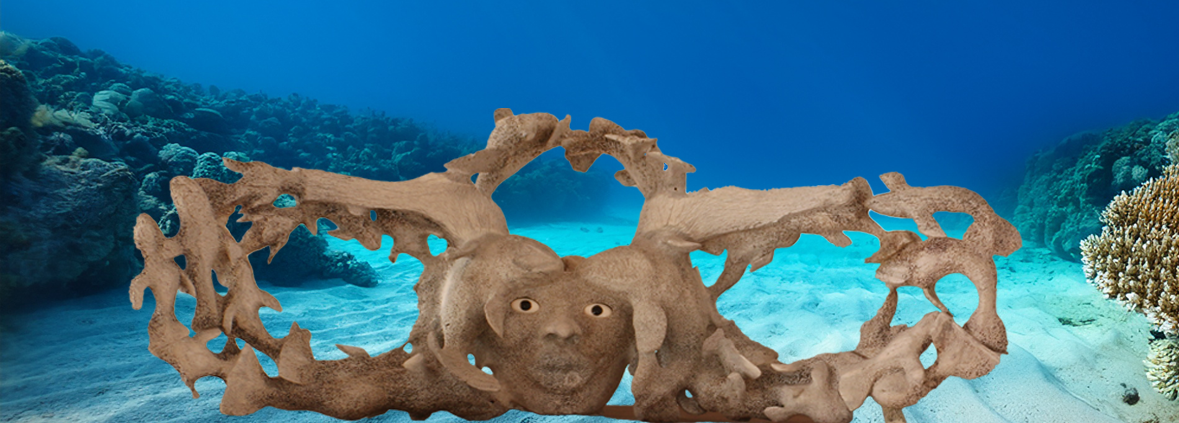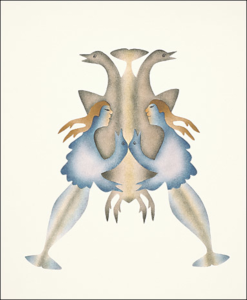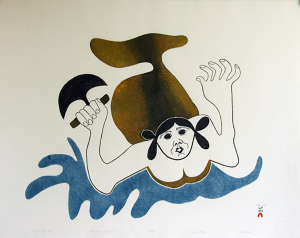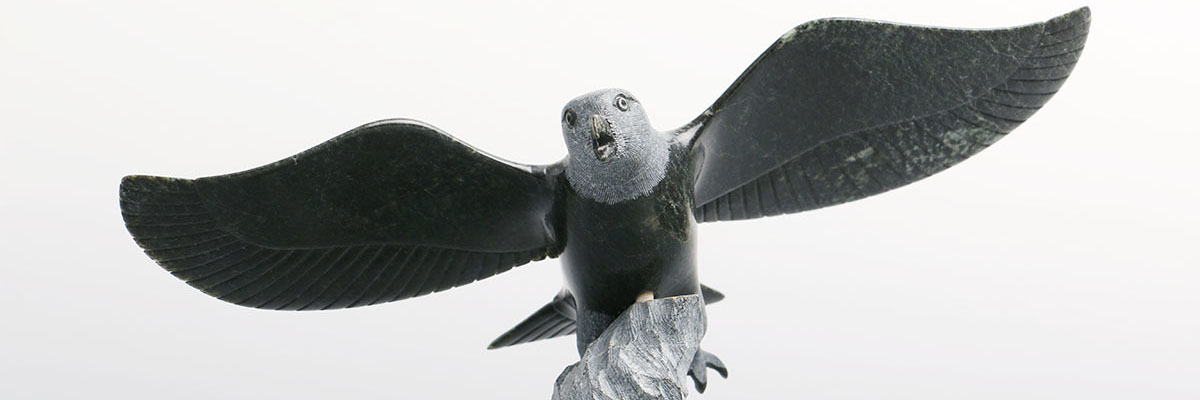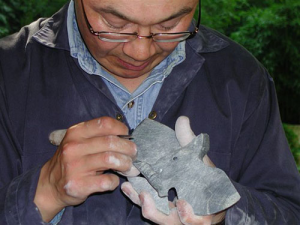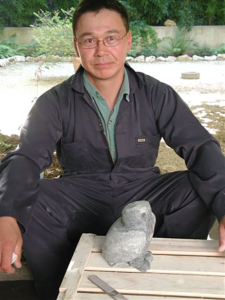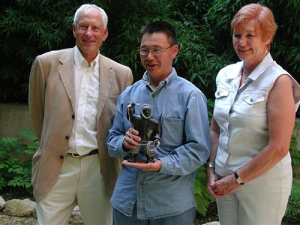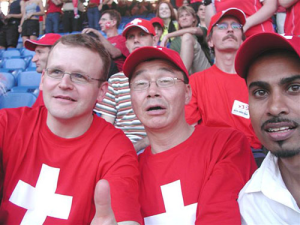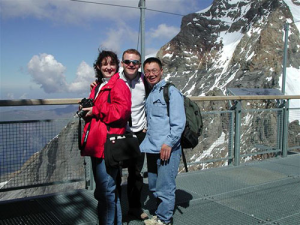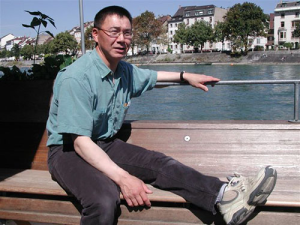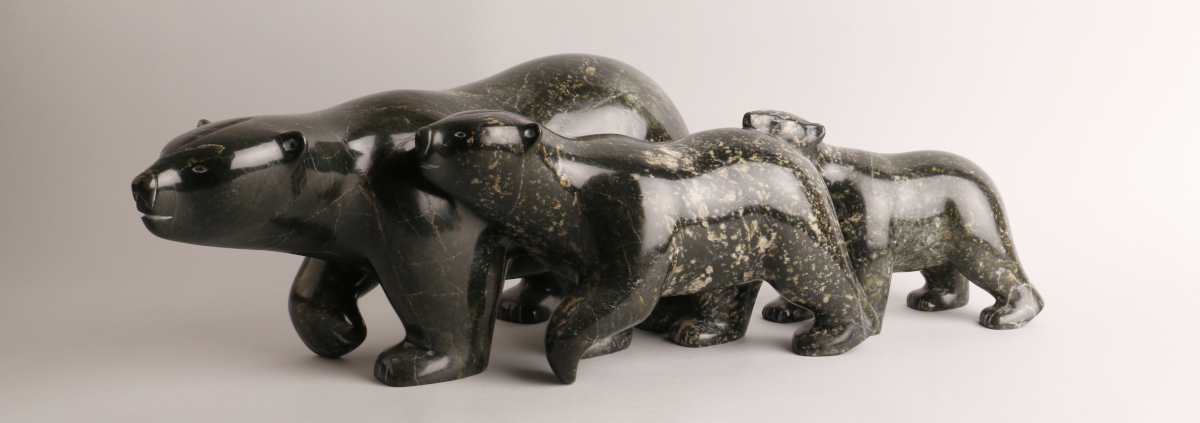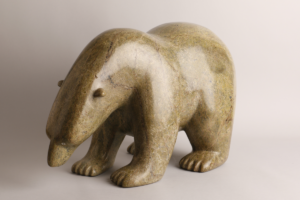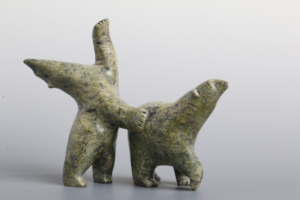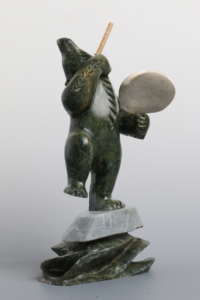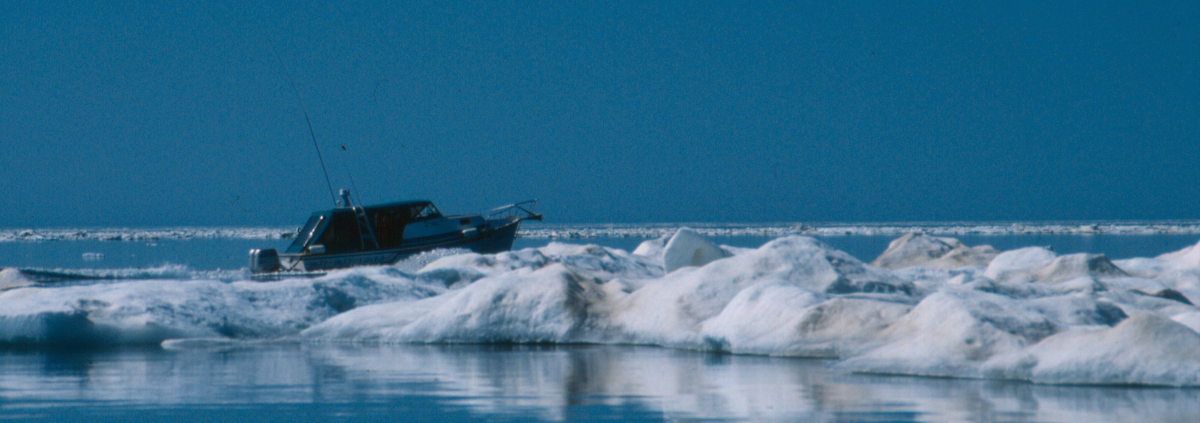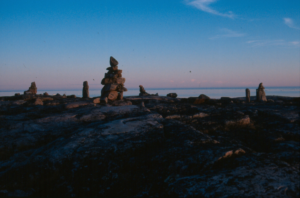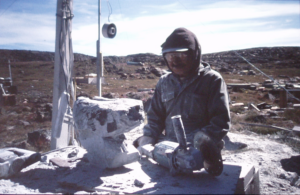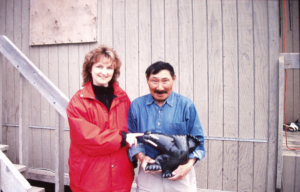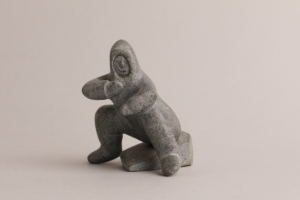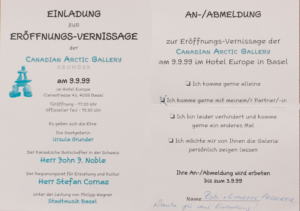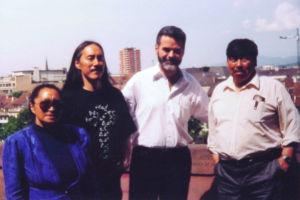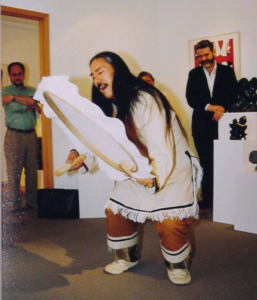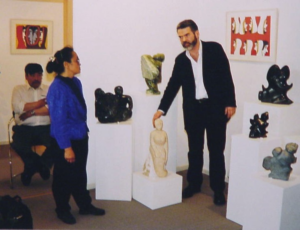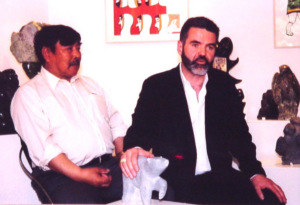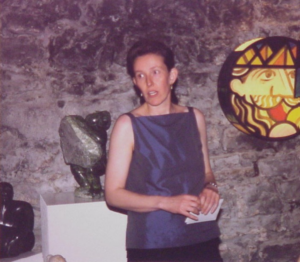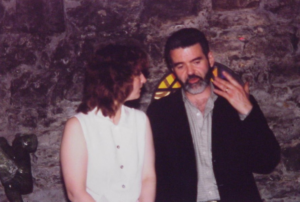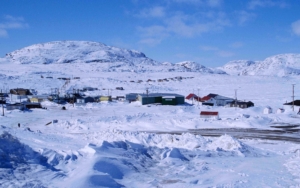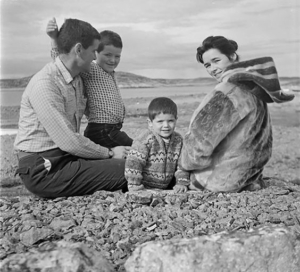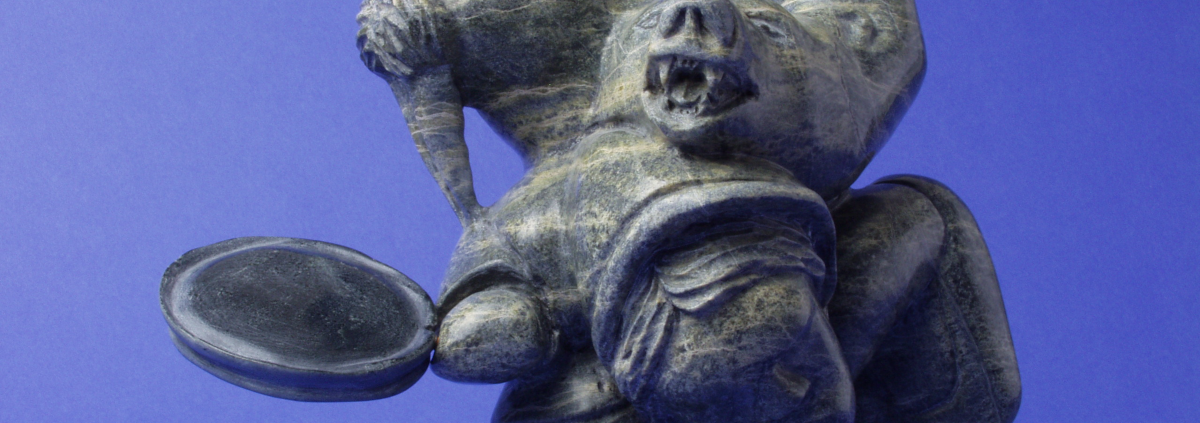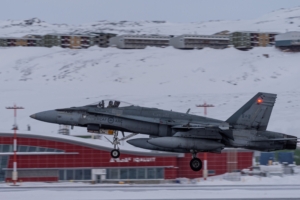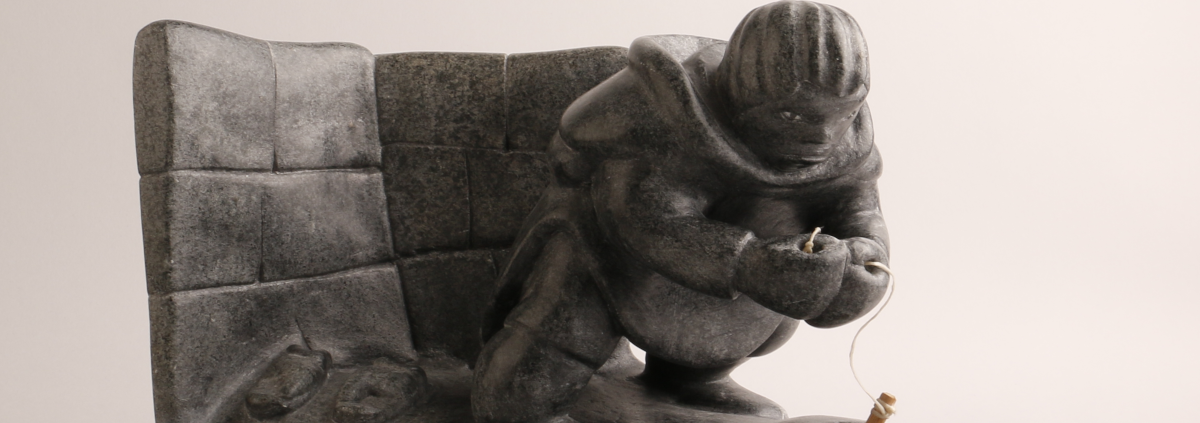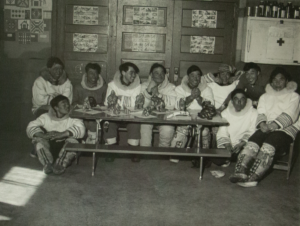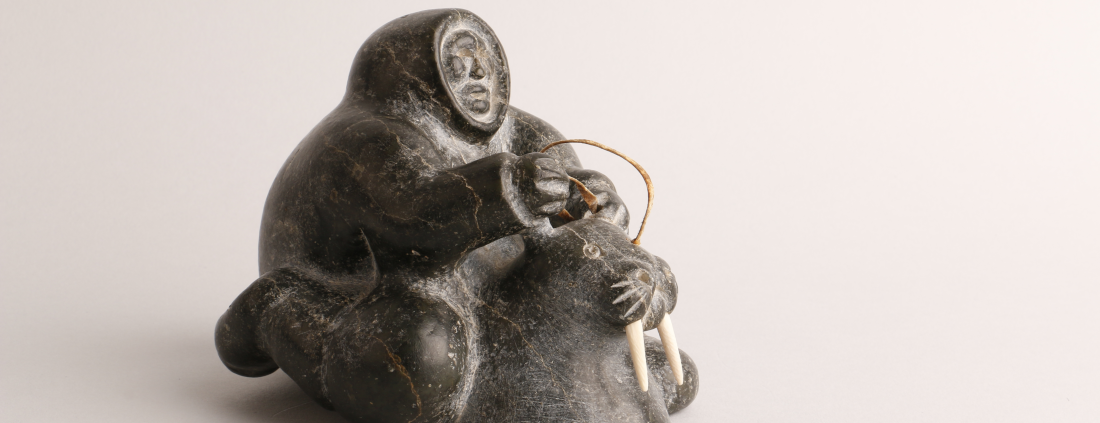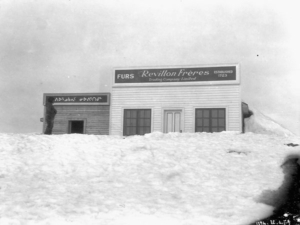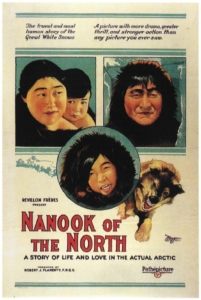Sedna is the goddess of the sea and sea creatures, especially seals, whales and fish – in other words, all the animals that the Inuit traditionally live off. She is often depicted as the ruler of the underwater world and is a kind of creator or guardian of marine life.
Sedna’s Helpers by Ida Karpik
“Once upon a time, there was a young girl called Sedna who lived with her father in a small village on the edge of the ice. Many men wanted to marry her, but she rejected every one of them. Some said she was proud. Others whispered that she was different.
One day a stranger came, dressed in fine furs. He promised her warmth, food and a life far from the cold. Sedna agreed and went with him. But when they arrived at his island, she realized the deception: the man was not human, but a petrel, and his home was barren and cold.
Sedna cried, and her lament summoned her father. Full of guilt and fear, he brought her back in his kayak. But the petrel was angry and caused the sea to roar. The waves grew higher and the sky turned black. The father, terrified of death, pushed Sedna overboard. She clung to the kayak, begging and screaming. To save himself, her father cut off her fingers, one by one. Each finger turned into an animal in the water: seal, whale, walrus.
Sedna sank into the depths – full of pain, full of anger. Down there in the dark water, she built herself a realm of cold and silence. She has lived there ever since, with flowing hair and no hands. The animals of the sea belong to her.”
Out of the Sea by Pitaloosie Saila
And when the people above forget her or break her rules, she holds the animals back. Then a shaman must travel to her, in a trance, through darkness and water, and comb her hair, which she can no longer care for herself. Only then does she forgive – and allow the hunt to resume.
Pitsiula grew up in Kimmirut and learned carving as a young boy from both his parents. He started by sanding down his parents’ carvings and when he was almost a teenager, he began to create his own works of art. At first he worked with hand tools, later he learned to use power tools.
Pitsiula Qimirpik working at Canadian Arctic Gallery, Basel 2004
(Photo: © Canadian Arctic Gallery, Switzerland)
Pitsiula had a connection to the owl. His mother had an owl as a little girl that was abandoned. She said the owl followed her everywhere, and even when it learned to fly, it always came back. Pitsiula’s mother told him the story of the owl when he was a little boy, and so he started carving owls… His mother inspired him to carve, and it became his passion.
Pitsiula Qimirpik at a short break at Canadian Arctic Gallery, Basel 2004
(Photo: © Canadian Arctic Gallery, Switzerland)
On September 3, 2004 we opened the solo exhibition ‘Pitsiula Qimirpik’. On the occasion of the opening we invited Pitsiula and RJ Ramrattan from Canadian Arctic Producers to Basel. We were able to enjoy the opening of the exhibition in beautiful fall weather and the collectors were also pleased to meet the artist in person.
Pitsiula Qimirpik with collectors at Canadian Arctic Gallery, Basel 2004
(Photo: © Canadian Arctic Gallery, Switzerland)
But art wasn’t the only thing at the center of the action. As Pitsiula and RJ are just as crazy about football as my husband, they attended the Switzerland-Ireland World Cup qualifier together in St. Jakob Park that evening.
Christian Grunder, Pisiula Qimirpik and RJ at the soccer game in St. Jakob Park, Basel 2004 (Photo: © Canadian Arctic Gallery, Switzerland)
For the artists of the Arctic, a visit to the Jungfraujoch – Top of Europe – is always an unforgettable highlight. The majestic view of the snow-capped peaks and the breathtaking Alpine landscape leaves a lasting impression. If the weather cooperates and the view can sweep far into the valley, the experience becomes even more impressive – an encounter of Arctic and Alpine beauty at the highest level.
Ursula & Christian Grunder and Pisiula Qimirpik on Jungfraujoch – Top of Europe, 2004 (Photo: © Canadian Arctic Gallery, Switzerland)
On October 15, 2024, Pitsiula died in a boating accident near his home community while searching for serpentinite for new works of art with his son. Grateful to have spent great times and laughed together with him, we remember these precious moments.
Pisiula Qimirpik enjoying a ride by the ferry on the Rhine, Basel 2004
(Photo: © Canadian Arctic Gallery, Switzerland)
Polar bears (Ursus maritimus) live almost exclusively on pack ice; some of them have never had solid ground under their paws in their entire lives. The animals are perfectly adapted to life in the Arctic. Their thick fur and a thick layer of fat protect them from the icy cold. Skin protrusions on the soles of their feet act like tiny suction cups, preventing them from slipping on the ice. The fact that polar bears have the smallest ears compared to other bears is a concession to the cold climate. However, the rest of their body mass is enormous: an adult male can weigh over 900 kg and reach a length of 3.1 meters.
Sniffing Bear by Adamie Ashevak, Kinngait (Cape Dorset) 2003
(Photo: © Canadian Arctic Gallery, Switzerland)
Polar bears can smell their prey at a distance of up to 32 km, which is why they occasionally stand on their hind legs to filter the air better. They also stand on their hind legs to wrestle with other bears and thus train their muscles.
Bears by Noo Atsiaq, Kinngait (Cape Dorset), 2009
(Photo: © Canadian Arctic Gallery, Switzerland)
But polar bears play an important role in Inuit shamanism too. As the king of the Arctic – respected and admired for their endurance and strength – they are the most important helping or protective spirits of a shaman. The “dancing” polar bears frequently depicted in Inuit art are also to be understood as a symbol of a helping spirit or the representation of a transformation of the shaman into a polar bear. Through this transformation, the shaman gains the animal’s power, enabling him to complete the tasks set on his spiritual journey.
Dancing Bear by Darrold Taylor, Tuktoyaktuk, 2014
(Photo: © Canadian Arctic Gallery, Switzerland)
On our first trip to the Arctic, we first visited Kinngait. We spent the first night in a house on the beach before setting off on our journey to an outpost camp.
On the way to the camp, we passed floating ice, rock faces covered in birds’ nests and visited Inukshuk Point. Tradition has it that people set off on long journeys from this point and left a souvenir in the form of an Inukshuk before they left, so that they could find their way back safely to this place.
Inukshuk Point at dusk
(Photo: © Canadian Arctic Gallery, Switzerland, July 2002)
The three-day camp experience involved traveling there, setting up the camp, fishing, preparing the fish, seal hunting in the fog, preparing and cooking the seal, taking down the camp and traveling back. The 7-hour boat trip meant that you could still feel the swell on land afterwards.
Nevertheless, we explored Kinngait and met some artists who were working in front of their sheds. Word had already spread that two ‘Qallunaat’ (meaning white/non-Inuit) from Switzerland were looking for new artworks for their gallery, which specializes in Inuit art, so we were welcomed with open arms.
Aqjangajuk Shaa during a short break
(Photo: © Canadian Arctic Gallery, Switzerland, July 2002)
Aqjangajuk Shaa even took a break so that we could photograph him in front of a work of art in progress. Although we couldn’t talk directly, we found a way to communicate through his son Alariaq Shaa – who was sculpting next door – and so at the end of our stay in Kinngait we managed to purchase the dancing walrus that Aqjangajuk had created during our stay.
Aqjangajuk Shaa and Ursula Grunder at the handover of the dancing walrus in front of his home
(Photo: © Canadian Arctic Gallery, Switzerland, July 2002)
We are extremely grateful that we were lucky enough to meet Aqjangajuk in person. He was one of the great sculptors in Kinngait and has passed on his knowledge to his sons (Pudlalik, Alariaq and Qiatsuq) and his grandchildren (Salomonie and Samonie). Our meeting and conversation with Aqjangajuk and Alariaq Shaa showed us why his dancing walruses and bears radiate such cheerfulness. Aqjangajuk was a kind-hearted and cheerful man who was always ready for a joke.
It was an impressive stay in Kinngait, from which we took home a wealth of experience, many valuable encounters and memories that will last a lifetime.
In 1996, on our first trip to Canada, we came into contact with this wonderful art created by the Inuit from the Canadian Arctic for the first time in a gallery in Toronto. The energy that radiated from these artworks was immense and left a lasting impression on us.
Inuk Sitting
(Photo: © Canadian Arctic Gallery, Switzerland)
We loved this little guy and took him home with us. Every time we passed it, he seemed to ask: when are you opening a gallery in Switzerland? In 1998, on our second trip to Canada, we stumbled across another Inuit art exhibition at the Convention Center in Vancouver. The starting signal for the ‘Inuit Art Gallery’ project had been given. Less than a year later, on September 9, 1999, we opened our gallery with a special event at the Hotel Europe in the presence of Canadian Ambassador John J. Noble, Basel’s Director of Education Stefan Cornaz and with musical accompaniment by the Stadtmusik Basel.
Invitation to the official opening of Canadian Arctic Gallery in 1999
(Photo: © Canadian Arctic Gallery, Switzerland)
Nine months later, we received our first visit from the Arctic. On their trip to Switzerland, Ovilu Tunnillie, Kananginak Pootoogook, Pakak Inukshuk and John Houston made a detour to our gallery in Basel.
Ovilu Tunnillie, Pakak Inukshuk, John Houston and Kananginak Pootoogook on Pfalz, Basel-Switzerland
(Photo: © Canadian Arctic Gallery, Switzerland, May 2000)
In the morning, Pakak Inukshuk drummed to generate good energy for the gallery…
Pakak Inukshuk drum dancing at Canadian Arctic Gallery, Basel-Switzerland
(Photo: © Canadian Arctic Gallery, Switzerland, May 2000)
… and Ovilu as well as Kananginak talked about their live as artist and their culture and believes.
Ovilu Tunnillie talking about her art at Canadian Arctic Gallery, Basel-Switzerland
(Photo: © Canadian Arctic Gallery, Switzerland, May 2000)
Kananginak Pootoogook talking about his art at Canadian Arctic Gallery, Basel-Switzerland
(Photo: © Canadian Arctic Gallery, Switzerland, May 2000)
And the big event ‘Arctic Live Evening’ was opened by Dr. Wiepke Ahrndt in the Cliqué cellar of the Lälli-Cliqué…
Dr. Wiepke Ahrndt at the opening reception , Cliqué cellar Lälli Cliqué in Basel-Switzerland
(Photo: © Canadian Arctic Gallery, Switzerland, May 2000)
… followed by insights into Inuit art by John Houston and Ursula Grunder. It was a very special and moving evening in this spectacular cellar, which is not normally open to the public. We still recall the vibrations caused by Pakak Inukshuk’s drum dance.
Ursula Grunder and John Houston talking about Inuit art, Cliqué cellar Lälli-Cliqué Basel-Switzerland
(Photo: © Canadian Arctic Gallery, Switzerland, May 2000)
And thanks to you – dear Inuit art and culture enthusiasts – this was not the last event of the Canadian Arctic Gallery, but today we can celebrate our 25th anniversary. We would like to express our sincere thanks to you.
Kinngait is located on Dorset Island, one of a group of islands off the southern coast of the Foxe Peninsula. In 1913 the Hudson’s Bay Company opened a trading post here and from 1939 to 1949 the Baffin Trading Company operated a competing trade. In the early 1950s, the catchment area of camps trading with Kinngait ranged from Amadjuak Camp, 280 km to the east, to Nuvuqjuaq Camp, 190 km up the west coast.
Part of Kinngait village with Kinngait Mountain
(Photo: Ansgar Walk, May 1997; credit: Wikipedia)
When James and Alma Houston arrived in Kinngait in the spring of 1951, they were delighted with the artistic potential they found in the camps around Kinngait. In contrast to the eastern shores of Hudson Bay, artists like Osuitok Ipeelee had already made a name for themselves with their ivory carvings. In fact, Houston was impressed with the overall art experience in Kinngait. He explained:
“Cape Dorset was quite different from either the east or west coast of Hudson Bay. I am still not sure why that was – perhaps because word of our attempted encouragement of Eskimo art had gone before us. I found the Inuit trading into Cape Dorset to be the most exciting, friendly, volatile, and certainly, the most talented Inuit group I had ever met. The Dorset people began right away to bring in carvings and seemed delighted with their payment slips that gave them instant trading power atthe Hudson’s Bay Company. The Baffin Trading Company had just disappeared after some years of somewhat bitter competition.
Perhaps we were fortunate that there was so little walrus ivory available in Cape Dorset, for the carvers immediately returned to thatage old medium, soft stone. Not too soft, mind you, for the carvers hate the kind that while being worked will crumble or crack apart, destroying many hours or days of work. The first stone we found in Cape Dorset was rather dark and coarse. It had the look of granite and came from around Kiaktook and down the fjord near Tessiakjuak. Manumi, the carver, found a small but good deposit near the north camp at Nuvudjuak.
Only a number of years later did we finally discover the rich deposit of a green stone (serpentine stone) just east of Amadjuak. This stone was perhaps of the finest quality ever discovered in the Canadian Arctic. It had a deep green jade-like lustre and would polish beautifully. All the large early stone blocks used for printmaking came from this deposit, alas, , is now nearly depleted.” (Excerpt from ‘Early Masters: Inuit Sculpture 1949-1955’, p. 135-136)
After collecting carvings in Kinngait for a summer, the Houstons left the settlement aboard the C.D. Howe on August 14, 1951, to continue traveling around Baffin Island to find possible artists and artworks in other settlements. The new carvings – especially those from Kinngait – soon attracted international attention. The extraordinary exhibition “Eskimo Art”, shown by the National Gallery in Ottawa, opened with a gala on January 18, 1952 and included 69 works of art, 45 of them created by artists from Kinngait.
James, John, Samuel, and Alma Houston in Cape Dorset, Nunavut, 1960.
(Photo: Rosemary Gilliat Eaton, credit: Art Canada Institute)
In November 1953, the Houstons were recruited by the federal Department of Resources and Development and continued to build the art program alongside the Kinngait artists, with whom they had a deep affinity. With great commitment and empathy, they also developed the two-dimensional art sector with drawings and, in part, the resulting graphics, in addition to the three-dimensional sculptures. When they left Kinngait in 1962, they had found a competent successor in Terry Ryan (1933-2017).
There are so many well-known artists in Kinngait that a list would not do them justice. Some of them will therefore be presented in future posts. For a small sneak a peek, you can find works of art from Kinngait by clicking on the link.
Sources of information: “Early Masters: Inuit Sculpture 1949-1955” (by Darlene CowardWight, The Winnipeg Art Gallery, 2006), “Kinngait” (Wikipedia) and „Pitseolak Ashoona“ (by Christine Lalonde, Art Canada Institute)
After James Houston visited the communities of Inukjuak and Puvirnituq in 1949 and 1950, he turned his attention to Baffin Island. Accompanied by his wife Alma Bardon, James Houston embarked on an expedition to Baffin Island in January 1951, shortly after their marriage. Instead of a conventional honeymoon, they took the chance to explore and document the handicraft potential of Baffin Island.
Their journey began with a flight from Montreal to Goose Bay, Labrador, with the Royal Canadian Air Force. From there, they continued their flight to Iqaluit, which at the time was a jointly controlled air base. This journey would have been quite an adventure, considering the remote and rugged nature of the Canadian Arctic at that time.
CF-18 fighters taking off from Iqaluit, NU, January 2021
(© DND/CAF)
Arriving in Iqaluit on February 17, 1951, they stayed only for one month. During their time there, they observed that many Inuit were employed in providing support services to the Royal Canadian Air Force (RCAF) base, highlighting the significant influence of the military presence in the region. The air base in Iqaluit was part of the DEW line (late 1950s until early 1990s) within “The Northern Defense System”. Although it is no longer called the Northern Defense System today, it still holds significant importance due to several key factors:
- Geopolitical Significance: The Canadian Arctic is strategically positioned between North America, Europe, and Asia. As such, it holds geopolitical importance for Canada in terms of national security, defense, and sovereignty. The region serves as a vital gateway for monitoring and responding to potential threats, including those related to maritime security, resource exploitation, and territorial disputes.
- Sovereignty and Territorial Integrity: Canada asserts its sovereignty over the Arctic through the presence of military installations, including the Northern Defense System. These installations demonstrate Canada’s commitment to protecting its northern territories and ensuring the integrity of its borders in the face of potential challenges from other nations or actors.
- Surveillance and Early Warning: The Northern Defense System includes radar installations, monitoring stations, and other surveillance infrastructure designed to detect and track air and maritime traffic in the Arctic region. This early warning capability is crucial for identifying and responding to potential security threats, including unauthorized or suspicious incursions into Canadian airspace or waters.
- Search and Rescue Operations: The harsh and remote environment of the Canadian Arctic presents unique challenges for search and rescue operations. The Northern Defense System plays a critical role in coordinating and supporting search and rescue efforts, providing assistance to aircraft, ships, and individuals in distress in the vast and often inhospitable Arctic landscape.
- Support for Northern Communities: In addition to its defense and security functions, the Northern Defense System also provides important support and services to northern communities. This includes infrastructure development, employment opportunities, and logistical support, contributing to the economic and social well-being of residents living in remote and isolated areas of the Canadian Arctic.
For the mission of the Houstons, this was kind of a setback. But anyway, they noted that the sewing of sealskins, used to make items such as slippers, mitts, and coats, had a market at the RCAF base. Also, there was no ivory available during their stay, but the Houstons were still able to acquire some soapstone carvings. Overall, the Houstons’ observations during their stay in Iqaluit provided valuable insights into the economic activities and artistic traditions of the local Inuit community, laying the groundwork for future collaborations and developments in the promotion of Inuit art and culture.
Some of the sought-after artists today came or still come from Iqaluit. Henry Evaluardjuk (1923-2007), Pootoogook Qiatsuk (b. 1959), Jackoposie Upakak (1948-2015), Joamie Aipeelee (1963-2020), Morris Alorut (b. 1963), Mathew Nugingaq (b. 1964).
Sources of information: “www.joint-forces.com” and “Early Masters: Inuit Sculpture 1949-1955” (by Darlene CowardWight, The Winnipeg Art Gallery, 2006)
Puvirnituq is located on the north bank of the Povungnituk River, four kilometers from Povungnituq Bay and about 400 km north of the tree line. Puvirnituq translates as “place where it smells of rotting meat”.
In 1921, the Hundson’s Bay Company opened an outpost near the present-day settlement. The Revillon Frères trading company was also active in this area until 1935. In 1952, the Hudson’s Bay Company moved its post away from the coast to the present location of the settlement. They also closed the trading posts in Cape Smith and Kangirsuruaq, which prompted the Inuit of this area to settle in Puvirnituq.
When James Houston was in Inukjuak in 1949, he also traveled by dogsled to Puvirnituq to meet potential Inuit artists. Unfortunately, the manager of the Hudson’s Bay Company at the time was solely responsible for Puvirnituq and Cape Smith (near Ivujivik) and was not present in Puvirnituq at the time, so James Houston returned to Inukjuak disappointed. Fortunately, he tried again the following year and was rewarded for his persistence. From 1951, the Hudson’s Bay Company took over the acquisition of the artworks. In the beginning, the Inuit of this region were rather reluctant to create works of art. This changed when Peter Murdoch arrived in Puvirnituq in 1955 and encouraged the people in their artistic work.
Fig. 1: Sculptors Society Members (Photo: Richard Harrington, 1959)
In 1956, a Catholic mission was founded and two years later, Father André Steinmann supported the residents in founding an artists’ association, from which the Co-operative Association of Povungnituk emerged in 1961. This was the first Inuit cooperative in the Canadian Arctic and a model that many artists in other Arctic settlements followed. The Co-operative Association of Povungnituk is still one of the most active cooperatives today, part of La Fédération des Co-opératives du Nouveau-Québec, which was formed in 1967 from several cooperatives from Nunavik (Arctic Quebec). Richard Harrington (1911-2005), a Canadian photographer, captured this historic moment with his camera. He traveled to Puvirnituq in 1959 to photograph the artists there and their life and work.
Wellknown artists from this community are Joe Talirunili (1906-1976), Levi Qumaluk (1919-1997), Davidialuk Alasua Amittu (1910-1976) and Charlie Sivuarapik (1911-1968) amongst others.
Sources of information: “Wikipedia” and “Early Masters: Inuit Sculpture 1949-1955” (by Darlene CowardWight, The Winnipeg Art Gallery, 2006)
Inukjuak is located on the northern bank of the Innuksuak River near Hopewell Sound on east Hudson Bay. The name of the settlement means “many people”. Ruins of stone houses from the pre-Dorset culture bear witness that this region has a long history of settlement. In the early days of the Colonization it was called “Port Harrison”.
Revillon Frères opened a trading post in Inukjuak in 1909. Revillon Frères was a French, globally active trading company for upmarket goods with fur products as its main item, which operated one of the first fur factories in Europe. In 1839, Victor Revillon acquired the Givelit company, which, at 116 years old, was now one of the oldest and most successful fur companies in Paris. The subsequent upswing of the company was based on two important business ideas. The first extremely successful idea of the Revillon couple was to make furs cheaper by also using fur types that had previously received less attention. The sons pursued a second business idea. Until then, the furs had only been processed into fur linings, trimmings and small fur items such as muffs, hats and scarves. Revillon began to process fur like fabric, first into jackets and then also into coats, always with the hair on the outside and according to the latest fashion. This expansion of the range revolutionized the entire furrier trade.
Fig. 1: Revillon Frères, purchase post (Credit: Wikipedia)
The company was so successful that it expanded to North America and procured the furs directly. In Canada, it thus competed with the powerful Hudson’s Bay Company, which maintained no fewer than 150 trading posts there. In 1920, the Hudson’s Bay Company also opened a trading post in Inukjuak. In 1926, the Hudson’s Bay Company acquired 54 percent of the company shares from Revillon Frères and in 1936 it was taken over completely by Hudson’s Bay.
Why such a long digression about the Revillon Frères company? Revillon had long had the idea of producing a film about the life of the Inuit, as the Inuit and First Nations were the main suppliers of skins. A film in Russia had not been made because of the February Revolution of 1917. In 1920, an expedition financed by Revillon began, planned for two years, to study and film the life of the Inuit. The film “Nanuk, the Eskimo” (original title: Nanook of the North; released in 1922) achieved worldwide fame and is one of the most important documentaries of the silent film era and one of the first feature-length films ever made. Director Robert J. Flaherty filmed the documentary about the everyday life of the Eskimo family of Nanuk and Nyla near the village of Inukjuaq.
Fig. 2: Original Movie Poster (Credit: Wikipedia)
But why is Inukjuak considered the cradle of contemporary Canadian Inuit art? James Houston discovered the craftsmanship of the Inuit here and convinced the Canadian Guild of Crafts in Montreal to show the artworks in sales exhibitions. In the years 1948-1950, he visited the camps that traded goods with the trading post in Inukjuak and showed the Inuit which objects (matchboxes, cigarette holders, ashtrays, …) could be created for the southern market using a booklet he had written and designed himself. Some of these old objects clearly show the influence of this brochure due to the decorations. Fortunately, these “souvenirs from the Arctic” did not catch on. The collector was much more interested in Arctic wildlife, the Inuit lifestyle and mythology.
The expressiveness of the small works of art did not go unnoticed by museum directors and, with the support of the Canadian government, the first Inuit art exhibition was shown in the Winnipeg Art Gallery as early as 1953.
After James Houston traveled to southern Baffin Island on behalf of the Canadian government in 1951 to explore the artistic abilities of the Inuit, Norman Ross, manager of the Hudson’s Bay trading post in Inukjuak, took care of the purchase and shipment of the artworks. In 1958, only 75 Inuit lived in the Inukjuak settlement. The remaining 263 lived in seven camps along the 160 km coastline and only visited the settlement for trading purposes. Each camp had its own camp leader, who was a respected figure and an exceptional hunter. The camp leaders quickly realized that the creation of small works of art was a more than welcome source of income after the collapse in the price of furs. They were among the first to sell works of art to James Housten. Among them were Akeeaktashuk (1898-1954, Camp Uugarsiuvik), Amidlak (1897-1961, Camp Quurnguq), Abraham Nastapoka (1900-1981, Camp Patirqtuuq) and Johnny Inukpuk (1911-2007, Camp Kuttaaq) all big names in today’s Inuit art world. Word of good things spreads quickly and so the camp leaders were soon followed by other members who also created great works of art, such as Abraham Talirunili P.O.V (1927-1994, Camp Kangirqsukallaq), Elijassiapik (1912-1972, Camp Kuttaaq) and Isa Smiler (1921-1986, Inukjuak).
Sources of information: “Wikipedia” and “Early Masters: Inuit Sculpture 1949-1955” (by Darlene CowardWight, The Winnipeg Art Gallery, 2006)

